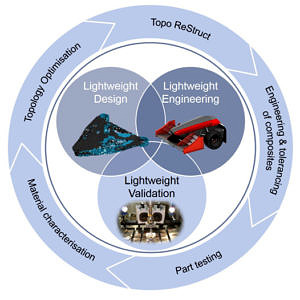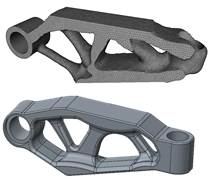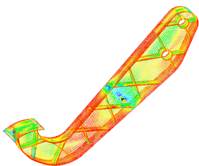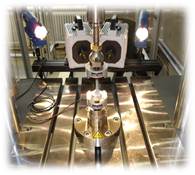Lightweight Design
Energy-efficient technical systems thanks to lightweight design
 The energy efficiency of technical systems has become more and more important in industry during the past few years. In this context, lightweight design has become a key factor in product development as a reduction in unnecessary weight means more energy-efficient products. KTmfk’s efforts in lightweight design can be divided into three core areas: simulation-based design, materials characterisation and structure optimisation. Within our research projects and working groups, we have already developed innovative solutions which make it possible to use the lightweight potential of technical systems in many applications.
The energy efficiency of technical systems has become more and more important in industry during the past few years. In this context, lightweight design has become a key factor in product development as a reduction in unnecessary weight means more energy-efficient products. KTmfk’s efforts in lightweight design can be divided into three core areas: simulation-based design, materials characterisation and structure optimisation. Within our research projects and working groups, we have already developed innovative solutions which make it possible to use the lightweight potential of technical systems in many applications.
Lightweight-Design
Structure optimisation in the design process
 Structure optimisation methods have proven to be effective tools for designing lightweight components in the product development process. However, the benefits of structure optimisation are often diminished by the time-consuming reconstruction and interpretation of the optimisation results. KTmfk is therefore developing methods and tools that enable to transfer optimisation results into feature-based CAD models.
Structure optimisation methods have proven to be effective tools for designing lightweight components in the product development process. However, the benefits of structure optimisation are often diminished by the time-consuming reconstruction and interpretation of the optimisation results. KTmfk is therefore developing methods and tools that enable to transfer optimisation results into feature-based CAD models.
Lightweight-Engineering
Design of fibre-reinforced plastic components in early product development
 Thanks to their excellent mechanical properties fibre-reinforced plastic components are used more and more often in modern lightweight structures. However, the design of fibrereinforced components presents a considerable challenge for product developers as the mechanical properties of these composites are largely dependent on the fibre orientation matching the exerted load. The development of strategies and methods to design fibre-reinforced plastic components is therefore crucial in the early stages of product development, focusing on short fibrereinforced thermoplastics and continuous carbon fibre reinforced plastics.
Thanks to their excellent mechanical properties fibre-reinforced plastic components are used more and more often in modern lightweight structures. However, the design of fibrereinforced components presents a considerable challenge for product developers as the mechanical properties of these composites are largely dependent on the fibre orientation matching the exerted load. The development of strategies and methods to design fibre-reinforced plastic components is therefore crucial in the early stages of product development, focusing on short fibrereinforced thermoplastics and continuous carbon fibre reinforced plastics.
Tolerancing of optimised fibre reinforced structures
Fibre reinforced plastics (FRP) have a high potential for lightweight design, but also bring with them a large number of additional design parameters (fibre angle, layer thickness). Deviations in design parameters due to manufacturing inaccuracies can lead to undesirable deformations due to coupling in the laminate. For this reason, a method is being developed which recognizes influential design parameters during the design of the component and enables appropriate tolerances.
Lightweight-Validation
Characterisation of materials under highly dynamic load
 Before simulating a component’s crash behaviour, its behaviour under a highly dynamic load must be determined precisely. At KTmfk, high-performance equipment is available for this purpose: a servohydraulic high-speed testing machine and an optical evaluation system with two high-speed cameras. The data obtained in this process are then used to create realistic simulation models.
Before simulating a component’s crash behaviour, its behaviour under a highly dynamic load must be determined precisely. At KTmfk, high-performance equipment is available for this purpose: a servohydraulic high-speed testing machine and an optical evaluation system with two high-speed cameras. The data obtained in this process are then used to create realistic simulation models.
You can download this information in compressed form in a flyer here.